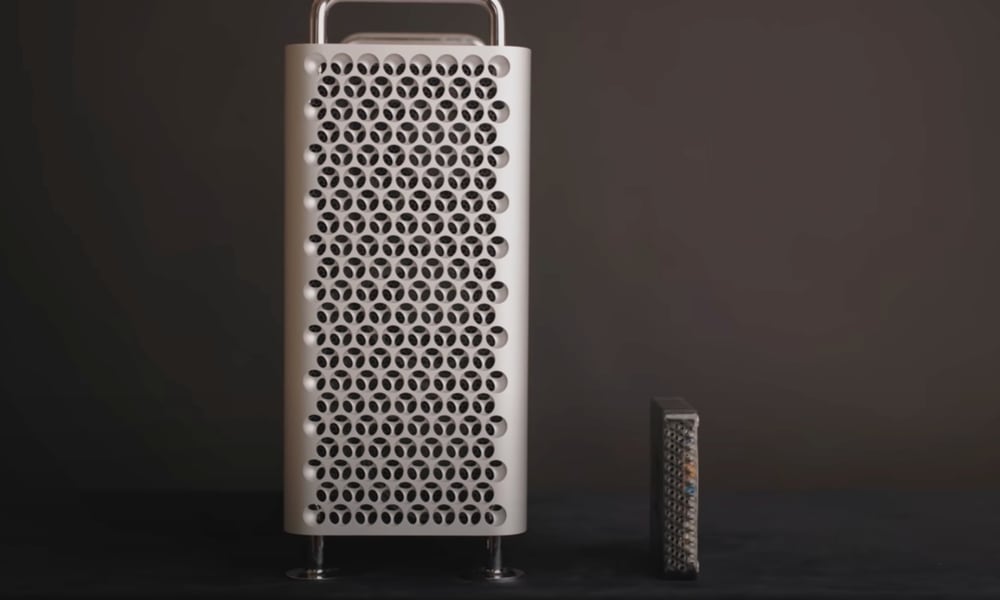Mac nano | This Man DIY’d the Mac mini to Become an Incredible 78% Smaller
 Credit: Snazzy Labs / YouTube
Credit: Snazzy Labs / YouTube
Toggle Dark Mode
Pound-for-pound, Apple’s Mac mini is already one of the smallest high-performing computers available, but a new YouTube video has demonstrated how Apple could make it even smaller — without sacrificing any of its power.
YouTuber Quinn Nelson, who runs the channel Snazzy Labs, demonstrates how it’s possible to make the Mac mini even more mini.
To accomplish this, he opens up the M1 Mac mini that we already know and love, scoops out the internals, and then makes a whole new enclosure to pack them into an even smaller space.
The result is a 78 percent reduction in the size of the Mac mini, although to be fair, he also eliminates the power supply as part of his DIY project — something that Apple would almost certainly loathe to do.
Still, as Nelson points out, the shift to Apple Silicon should still have allowed Apple a lot more leeway to shrink the Mac mini down to a smaller size, especially considering that it packed in the same power as the MacBook Air and even the 13-inch MacBook Pro, both of which are actually smaller by volume.
When the M1 computers debuted later that year, the Mac mini retained its same form factor — the same case that it had used since 2010. Now, make no mistake, the new Mac mini was powerful and packed a major punch compared to its predecessor, but when compared to the fanless MacBook Air that had that same M1 chip? Well, many people figured that Apple could have done better.Quinn Nelson, Snazzy Labs
Specifically, the Mac mini is approximately 83 cubic inches in size, which both of Apple’s M1 MacBooks come in at slightly over 60 cubic inches — and both of those include screens.
In fact, the Mac mini weighs only three ounces less than the MacBook Air, and, again, that’s without a display.
So, Nelson was pretty sure he could reduce the Mac mini to a much smaller size, and even upon opening it, he discovered that there was quite a bit of empty space inside.
To be fair, Apple didn’t really change any of its Mac designs for the initial M1 rollout, likely because it wanted the new Apple Silicon to be the biggest focus, and the only differentiator from the prior Intel models.
Nelson also adds that Apple’s biggest Mac mini customers — enterprises and schools — had already spent twelve years accommodating the design, with racks in data centres built around handling stacks of Mac minis. Changing up the design might have thrown them off as well.
However, Nelson’s experiment proves that it definitely could have been done, and that’s with the boards in the existing Mac mini, which Apple obviously wasn’t optimizing for size in the first place.
In other words, if Apple really wanted to, it could very likely make a Mac mini that’s even smaller than what Nelson came up with. Re-engineering the existing M1 Mac mini could easily produce smaller boards, and that’s not even considering what Apple may be able to pull off with the upcoming M2 chip.
While Nelson notes that his mini Mac mini benchmarked the same as an original, unadulterated M1 model, that probably wouldn’t be true for sustained workloads, as he sacrificed the fan in the process as well.
While that would likely result in some throttling if you were attempting to do things like render long stretches of 4K or 8K video, it’s most likely not something many users would notice.
Although there’s a good chance we’ll see a new Mac mini show up next week, it’s hard to say whether it’s going to get a redesign just yet. As things stand now, Apple has both an M1 and Intel Mac mini in the lineup, so the next one on deck could just be the higher-end Mac mini, which could retain the same design and get an M1 Pro chip.
On the other hand, Apple also redesigned its premium MacBook Pro lineup when the M1 Pro/Max configurations came along, but those are also the flagship Macs. By comparison, the Mac mini has become an oft-neglected part of the Mac family, and Nelson makes a valid point about Apple’s biggest customers liking the design just the way it is.
The fact that we’ve seen very few leaks about a new Mac mini redesign beyond the concept stages suggests that we probably shouldn’t expect much of a redesign quite yet. Still, it’s always wise to leave a bit of room for Apple to pull another rabbit out of its hat.








